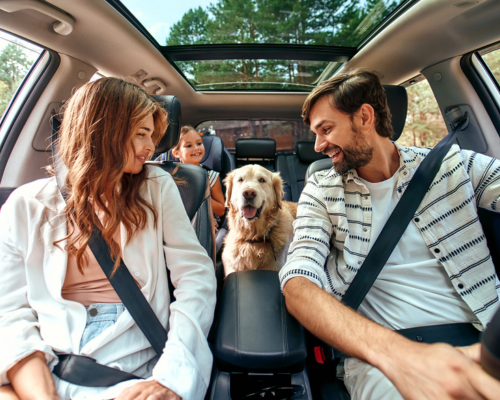Get some tips from experts for safe, sane and fun travel with the whole family.
Travel is a great way to experience new things, learn and even gain a bit of self-enlightenment.
Traveling with young kids offers the chance to share this and more as a family.
Traveling with pets promises grand adventures for everyone.
While there are many possible benefits of traveling with pets and kids, some parents may also see a potential for stress and challenges. But with proper planning, it can become a source of lifelong, positive memories for all members of the family — including Fluffy.
“Traveling with both young kids and your pet is not only doable, but it can also open the doors to some of the best family memories you’ll ever make. Is it easy? Not always. Does it sometimes smell like hot dog breath and leave wet nose streaks on the inside of your car windows that will likely stay there for months after you return from your trip? Probably. But is it worth it? Almost always, yes!” says Carmen Stramara, PCD(DONA) and CPST, who is a doula serving South Orange County, an educator at The Mommy Center in Laguna Hills and co-founder of Happily Raised online parenting platform.
Road Trip Prep
Stramara says that as someone who has spent the past 12 years moving and traveling around the world with two kids and three furry rescues, she can attest to the joys and challenges of hitting the road with the whole family.
“Driving in new places can feel stressful without the added pressures of a crying baby, cranky toddler or panting pup,” she says. “Keeping best safety practices a priority can reduce undue stress, so I always suggest finding the right restraint system for your pet, just as you did for finding the right car seat system for your child.”
Stramara says unrestrained pets can be a hazard to safe driving, potentially interfering with pedal control, causing distracted driving, disrupting airbag deployment and potentially becoming a forceful projectile in the event of an accident. Look for crash-tested harnesses or carriers that fit the size and weight of your furry friend.
“The right music can also help keep the carload calm. Make a playlist of music that helps you feel chill and add in some for the young ones too,” Stramara says. “A favorite recommendation is Rockabye Baby! station on your streaming service of choice and jam to lullaby renditions of your favorite songs.”
Stramara says planning ahead will also relieve stress on the road. As you’re mapping out your route, include rest stops at pet-friendly locations.
“It’s best to stop to stretch out and move every two hours on the road, so looking ahead can reduce the frantic search for a safe spot to pull over,” she says.
Bring a bag designated for pet supplies that stays easily accessible — including leashes, poop bags, food, water, any medications and a favorite comfort toy.
“Similarly, make sure the diaper bag isn’t buried at the bottom of the trunk. This will make pit stops smoother,” she says.
The diaper bag should be stocked with diapers, wipes, snacks, medications and changes of clothes.
Don’t forget a portable crate or bed for pets. This will give them a familiar and comfortable space to rest. Also, put together a pet first aid kit including bandages, antiseptic wipes, tweezers and any necessary medications.
For children, make sure that you have age-appropriate and properly installed car seats or booster seats. Bring a lightweight, foldable stroller and your favorite carrier if you plan to walk some nature trails.
Remember the entertainment for kids, including tablets, books, toys and games to keep them occupied.
Other Travel Considerations
Licensed Family Paws Educator and Certified Professional Dog Trainer Kate Uruchurtu of Calmer Canines LLC in Orange County, says that as with anything to do with kids or dogs, how well they travel together truly depends on how well their personalities, temperaments and energy levels match each other.
“If you have a high-energy kid who loves to move fast and go somewhere new every day, the kind of trip they’d enjoy — such as an amusement park marathon — wouldn’t be suitable to bring along any dog,” Uruchurtu says. “On the other hand, If you have a high-energy dog who needs significant exercise and mental stimulation, you’d need to plan a trip with lots of hiking or similar activities to keep them feeling settled in a hotel or Airbnb-type setting. A dog who struggles with going new places and/or meeting new people might not do well on any kind of trip, but a dog with mid-level energy who is very flexible and a kid — or kids — who are flexible and mid-level energy as well could go on a variety of trips. A stay at a dog-friendly cabin is often a great fit with access to hiking and nature for both the dogs and kids, and should make for a comfy place to rest at the end of the day.”
She says to be aware of the weather forecast of where you’ll be going. Use BringFido to find pet-friendly attractions, trails, restaurants and lodging — but be sure to check the website or call each establishment to verify.
“Make sure your dog is on appropriate parasite prevention for the area you’ll be visiting — which may include flea, tick and heartworm — and verify whether your dog is up-to-date with vaccines or titer tests — and whether titer tests are accepted where you’re going,” Uruchurtu says. “Ensure your dog’s ID tag is still legible and has current cell phone numbers. Especially if you plan to travel with your dog often, it’s a good idea to create a vacation ID that includes an email address in case of poor cell reception and ‘I’m lost on vacation’ so people know how truly lost your dog is if they manage to get away.”
She says to look up where the nearest veterinarian is in every location you’ll visit in case of emergency. If you’ll be hiking where you may encounter rattlesnakes, you’ll need to know where the nearest vet is who carries antivenom — and be aware of the costs. If you’ll be flying, verify all requirements for carriers with your airline several weeks in advance.
Uruchurtu says calming collars or bandanas with dog-appeasing pheromone sprayed on them may also help your dog feel relaxed.
“I wouldn’t recommend flying anywhere with a dog for a vacation unless your pup is both small enough to fit in a soft carrier under the seat and already quite accustomed to flying without stress,” Uruchurtu says. “Flying in cargo can be incredibly stressful and is very risky in hot or cold weather — it’s absolutely not worth it for a vacation since your dog could become stressed, ill or injured during the flight. Road trips can be more trying and require much more planning than a more local weekend getaway — within two to three hours’ drive of home — but they also create a lot of potential for adventure.”
She says she would not recommend traveling internationally with a dog unless you are moving — since many countries (and Hawaii) require lengthy quarantines and because there are also new regulations regarding bringing dogs into the country.
“As of Aug. 1, 2024, any dog entering the United States, even if they came from the United States and are returning, must be microchipped, vaccinated against rabies, be at least 6 months old, appear healthy upon arrival and be accompanied by a CDC Dog Import Form,” she says. “Should any of these requirements not be met, you will be charged to ship your dog back to the last country they were in, meaning they cannot return home.”
Uruchurtu says her favorite places to travel with kids and pets include a pet-friendly Airbnb or a La Quinta Inn.
“La Quinta is well-known in the dog community for being pet-friendly, they are affordable and they are everywhere, making them an excellent choice for road trips,” she says. “Some locations have swimming pools, which are great for kids, but you’ll want to give your pup a nap in the room while the kids swim, so it’s important that your dog is comfortable being left alone for a bit — and it’s best to leave them in a crate, just in case they get curious in a new place.”
By Jessica Peralta










Leave a Reply